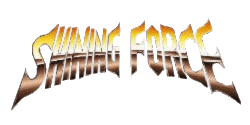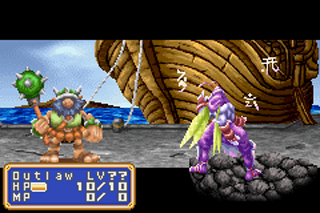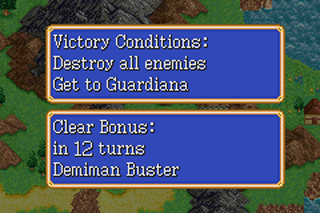|
|

|
PLATFORM
|
GBA
|
BATTLE SYSTEM
|

|
INTERACTION
|

|
ORIGINALITY
|

|
STORY
|

|
MUSIC & SOUND
|

|
VISUALS
|

|
CHALLENGE
|
Moderate
|
COMPLETION TIME
|
20-40 Hours
|
|
OVERALL

|
+ Fun combat.
+ Solid story.
- Combat can be unbalanced late in the game.
- Music and graphics could have used more polish.
|
Click here for scoring definitions
|
|
|
Ages ago, Light fought Darkness for control of the world, with the Dark Dragon leading the forces of Darkness, and the Ancients leading the forces of Light. The Ancients defeated the Dark Dragon, who vowed to return in a millennium. During that intervention, the land of Rune enjoyed an era of peace, although afterward, the Kingdom of Runefaust brings war to the land, which awaits a hero who can wield the Powers of Light. Sega's Shining Force: Resurrection of the Dark Dragon for the Gameboy Advance is a remake of Shining Force on the Sega Genesis, and proves to be an all-around solid experience in spite of some faults.
Like the original, the remake features several chapters where the player, between battles, can wander around towns to shop and perform various tasks at churches, including saving the game, and explore a limited overworld and small dungeons. Before one of the many battles necessary to advance the story begins, the player can set up a party of up to twelve characters of different classes to participate, with the protagonist, Max, being mandatory. Once a battle begins, characters and enemies take their turns depending upon agility, and move across grid-based terrain that can in some cases restrict their area of movement.
 Zuika's language attack
Zuika's language attack
|
|
Characters can perform several commands during combat, including attacking the enemy, using magic (with spells able to have up to four adjustable levels of power), using items, or simply staying put. When they perform a command other than staying put, they gain a number of experience points, with a hundred being necessary to level, after which the leveling character's stats increase somewhat. When characters reach level ten, the player can promote them to an upper class, in which case their level resets to one, their stats slightly decrease, and they can access weapons that are more powerful. However, the maximum level in a character's initial class is twenty, so it is in some instances a wise decision not to promote characters right away.
It's also a wise idea to level up promoted characters right away to compensate for the stat loss upon promotion so that they don't become useless late in the game. Although combat can possibly become unbalanced late in the game depending upon how the player levels characters, it's still enjoyable, with Max's ability to egress from battle with a spell throughout most of the game allowing for grinding if necessary. If Max dies, the player loses a battle at a penalty of half the party's money, although it is possible to put money into a bank at headquarters to somewhat compensate for this loss. Overall, the battle system is one of the game's highlights, with some new features in the remake such as a character who can use cards to imitate the abilities of allies.
Interaction is slightly better than in the Genesis version, given new features such as an item box where the player can stash excess items and the ability to see how equipment affects character stats before buying and equipping it, but the menus still feel clunky, and merchants still barrage the player with dialogue when shopping. Still, the game's linear structure makes it a no-brainer on how to advance, and overall, the interface is adequate, yet could have been better.
 Also new to the remake is prizes for finishing battles quickly
Also new to the remake is prizes for finishing battles quickly
|
|
The original Shining Force was one of the first tactical RPGs, so it was naturally an inventive title, with the remake largely preserving its simple tactical gameplay while having a few new features such as some additional characters including one who makes use of cards the player can gain occasionally from talking to party members at headquarters.
The original version had a decent story for its time, which the remake improves upon, providing more backstory and even having a special incentive for using certain characters often in battle, in which case they'll occasionally reveal bits about themselves and the game's world at the player's headquarters. Some of their revelations are asinine, but the story is still solid overall.
The quality of the music is unfortunately no better than it was on the Sega Genesis, with most of the soundtrack remaining intact in the remake, even though many tracks, such as the overworld theme, are decent. The graphics, however, are noticeably different, with the character sprites on top-down maps having chibi proportions and generally looking silly, though the scenes where characters and the enemies engage look solid. Still, the music and graphics could have definitely used a bit more polish in the remake.
Finally, the remake is about twenty hours long, though the last few battles may require some grinding, given their potential unbalanced nature, with a replay mode allowing for harder enemies. Overall, Shining Force: Resurrection of the Dark Dragon is an enjoyable remake that preserves the simple tactical gameplay of the original with slight enhancements. The music and graphics aren't too much to write home about, although the story is solid, and given the straightforward nature of the gameplay, Shining Force is a decent diving board into tactical RPGs.
Review Archives
|









